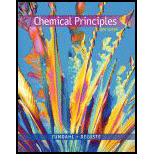
Concept explainers
(a)
Interpretation: The Lewis structure and resonance of given compounds.
Concept Introduction:
Lewis dot structure is the representation which shows the bonding between atoms present in a molecule. It shows lone pairs and bond pairs that existing on each bonded atom. Lewis dot structure is also known as Lewis dot formula or electron dot structure.
The sum of valence electrons must be arranged in such a way that all atoms must get octet configuration (8 electrons).
(b)
Interpretation: The Lewis structure and resonance of given compounds.
Concept Introduction:
Lewis dot structure is the representation which shows the bonding between atoms present in a molecule. It shows lone pairs and bond pairs that existing on each bonded atom. Lewis dot structure is also known as Lewis dot formula or electron dot structure.
The sum of valence electrons must be arranged in such a way that all atoms must get octet configuration (8 electrons).
Want to see the full answer?
Check out a sample textbook solution
Chapter 13 Solutions
Chemical Principles
- 2. each atom if it has. Show all steps (NHSB). Draw the Lewis structures for the following molecules. Indicate the formal charge on (a) N,²- (b) SO3 olda ad ni d Two molecules may both be correctly described as "bent" even though one has a bond angle of 118° and the other has a bond angle of 105°. How is this possible?arrow_forward3. a) The most plausible Lewis structure of azide ion, N3 could be determined using formal charge. (Proton number N=7) i. Draw all possible Lewis structures for azide ion.ii. Select the most plausible Lewis structure of the ion. Explain.arrow_forwardFf.84.arrow_forward
- 2. a. The Pauling scale of electronegativity is based upon bond dissociation energies, D, and involves using the equation DAB = (DAz × Dg2)"² + A . For what process does A represent the energy? How is A related to electronegativities? b. The electronegativities of H, S, and O are 2.2, 2.58, and 3.44 respectively. Explain the fact that the HOH bond angle in H,O is 104.5 ° while the HSH bond angle in H,S is only 92.1° i. based upon relative electronegativities and ii based upon atomic orbital hybridization.arrow_forwardWe can draw three inequivalent Lewis structures for the arsenite ion , AsO33- . The concepts of formal charge and electronegativity can help us choose the structure that is the best representation.1. Assign formal charges to the elements in each of the structures below.Note: Count oxygen atoms starting from the left for each structure. A B C Formal ChargeAsO1O2O3 2. The best Lewis structure for AsO33- is (A,B, or C)arrow_forwardplease explain in neat hand writingarrow_forward
- Which of the following species are not resonance forms of the anionic species in the box?" es. S: HS, 1 II II IV I and IV IIl and IV Il and IIIarrow_forwardIX. Use bond energies table to calculate AHxn for this reaction: CH4 + 3Cl₂ ⇒ CHCl3 + 3HCI O MBDarrow_forwardA east.cengagenow.com CHM 103 003 General Chemistry 1 C OWLV2 | Online teaching and learning resource from Cengage Learning [References) Draw the Lewis structures of the molecules below and use them to answer the following questions: ot I. BH3 П. NO, III. SF6 ot pt IV. O3 pt V. PCIS pt Which of these molecules show resonance? pt II, V OI, II pt III, V pt II, IV O III, IV | pt I pt Submit Answer Try Another Version 5 item attempts remaining Cengage Learning Cengage Technical Supportarrow_forward
- Which of the following molecules has the shortest nitrogen-to-nitrogen bond: N2H4, N20, N2, N204? Select one: O a. N2 O b. N204 O c. N2H4 d. N20 Several resonance structures for the molecule CO2 are shown. Which one of them is likely to be of little importance in describing the bonding in this molecule? Select one: a. 0=C3D0 O b. 0 C-0: 2+ - c. T0-C-Oarrow_forward3. Lewis structures of two chemical species are shown below. For each, give (i) the formal charge on each atom and (ii) the overall charge on each species. Structure a Structure b :F :O-CFo H- Atom 1 Atom 2 Atom 3 Atom 4 Atom 5 Хе Oa Ob Fa Fb H Cl Oa Ob Ос రీరేజిిarrow_forward5. In the table below copy the electronegativities of period 2 elements, then compare each to F by finding their difference in electronegativity (AEN), and their average electronegativity (AvgEN). Li Be F EN AEN (F) for Y-axisarrow_forward
 Chemistry by OpenStax (2015-05-04)ChemistryISBN:9781938168390Author:Klaus Theopold, Richard H Langley, Paul Flowers, William R. Robinson, Mark BlaserPublisher:OpenStax
Chemistry by OpenStax (2015-05-04)ChemistryISBN:9781938168390Author:Klaus Theopold, Richard H Langley, Paul Flowers, William R. Robinson, Mark BlaserPublisher:OpenStax Chemistry: An Atoms First ApproachChemistryISBN:9781305079243Author:Steven S. Zumdahl, Susan A. ZumdahlPublisher:Cengage Learning
Chemistry: An Atoms First ApproachChemistryISBN:9781305079243Author:Steven S. Zumdahl, Susan A. ZumdahlPublisher:Cengage Learning Organic ChemistryChemistryISBN:9781305580350Author:William H. Brown, Brent L. Iverson, Eric Anslyn, Christopher S. FootePublisher:Cengage Learning
Organic ChemistryChemistryISBN:9781305580350Author:William H. Brown, Brent L. Iverson, Eric Anslyn, Christopher S. FootePublisher:Cengage Learning
 ChemistryChemistryISBN:9781305957404Author:Steven S. Zumdahl, Susan A. Zumdahl, Donald J. DeCostePublisher:Cengage Learning
ChemistryChemistryISBN:9781305957404Author:Steven S. Zumdahl, Susan A. Zumdahl, Donald J. DeCostePublisher:Cengage Learning Chemistry: The Molecular ScienceChemistryISBN:9781285199047Author:John W. Moore, Conrad L. StanitskiPublisher:Cengage Learning
Chemistry: The Molecular ScienceChemistryISBN:9781285199047Author:John W. Moore, Conrad L. StanitskiPublisher:Cengage Learning





